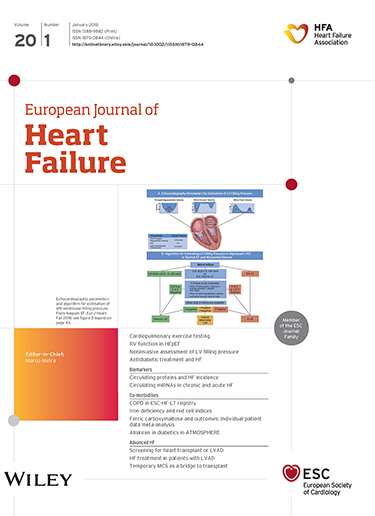Prediction and prognostic role of left ventricular systolic dysfunction in family screening for dilated cardiomyopathy and non‐dilated left ventricular cardiomyopathy
IF 16.9
1区 医学
Q1 CARDIAC & CARDIOVASCULAR SYSTEMS
引用次数: 0
Abstract
AimsThe prognostic significance of detecting left ventricular (LV) systolic dysfunction during family screening programmes (FSPs) in relatives of probands affected by dilated (DCM) and non‐dilated left ventricular (NDLVC) cardiomyopathies remain unclear. This study sought to evaluate the prognostic role of LV systolic dysfunction detection in relatives of DCM/NDLVC probands and to define the most accurate FSP.Methods and resultsBaseline and follow‐up data of first‐degree relatives of probands affected by DCM/NDLVC were collected. The primary outcome was all‐cause death and heart transplantation. Secondary heart failure (HF) and arrhythmic outcomes were also included. A total of 492 first degree relatives were enrolled. During a median follow‐up of 110 months (interquartile range 57–188 months), only subjects that previously developed LV systolic dysfunction had primary outcomes (19 vs. 0,左心室收缩功能障碍在扩张型心肌病和非扩张型左心室心肌病家族筛查中的预测和预后作用
目的:在受扩张型(DCM)和非扩张型左室(NDLVC)心肌病影响的先证亲属的家庭筛查计划(FSPs)中检测左室(LV)收缩功能障碍的预后意义尚不清楚。本研究旨在评估左室收缩功能障碍检测在DCM/NDLVC先证亲属中的预后作用,并确定最准确的FSP。方法与结果收集DCM/NDLVC患者一级亲属的基线及随访资料。主要结局是全因死亡和心脏移植。继发性心力衰竭(HF)和心律失常的结果也包括在内。共有492名一级亲属被招募。在中位随访110个月(四分位数间隔为57-188个月)期间,只有先前发生左室收缩功能障碍的受试者有主要结局(19 vs. 0, p <;0.001)和次要结局(HF: 12 vs. 0, p = 0.005;心律失常:30 vs. 0, p <;0.001)。FSP检测到左室收缩功能障碍的受试者的主要结局率较低(FSP: n = 19 [14%];no‐FSP: n = 40 [37%];p & lt;0.001)和继发性心律失常结局(FSP: n = 18 [13%];no‐FSP: n = 41 [38%];p & lt;0.001)。在这种情况下,心律失常家族史和作为致病/可能致病变异的携带者是左室收缩功能障碍的主要危险因素,而左室总纵应变(LV‐GLS)和动态心电图(ECG)在预测左室收缩功能障碍和结局方面显示出相关作用。结论DCM/NDLVC先知者的亲属在长期随访中出现左室收缩功能障碍的主要不良心血管结局的风险显著增加。FSP检测左室收缩功能障碍预后较好。在此背景下,遗传学、动态心电图和LV‐GLS证明了它们在疾病和事件预测中的功能作用。
本文章由计算机程序翻译,如有差异,请以英文原文为准。
求助全文
约1分钟内获得全文
求助全文
来源期刊

European Journal of Heart Failure
医学-心血管系统
CiteScore
27.30
自引率
11.50%
发文量
365
审稿时长
1 months
期刊介绍:
European Journal of Heart Failure is an international journal dedicated to advancing knowledge in the field of heart failure management. The journal publishes reviews and editorials aimed at improving understanding, prevention, investigation, and treatment of heart failure. It covers various disciplines such as molecular and cellular biology, pathology, physiology, electrophysiology, pharmacology, clinical sciences, social sciences, and population sciences. The journal welcomes submissions of manuscripts on basic, clinical, and population sciences, as well as original contributions on nursing, care of the elderly, primary care, health economics, and other related specialist fields. It is published monthly and has a readership that includes cardiologists, emergency room physicians, intensivists, internists, general physicians, cardiac nurses, diabetologists, epidemiologists, basic scientists focusing on cardiovascular research, and those working in rehabilitation. The journal is abstracted and indexed in various databases such as Academic Search, Embase, MEDLINE/PubMed, and Science Citation Index.
 求助内容:
求助内容: 应助结果提醒方式:
应助结果提醒方式:


